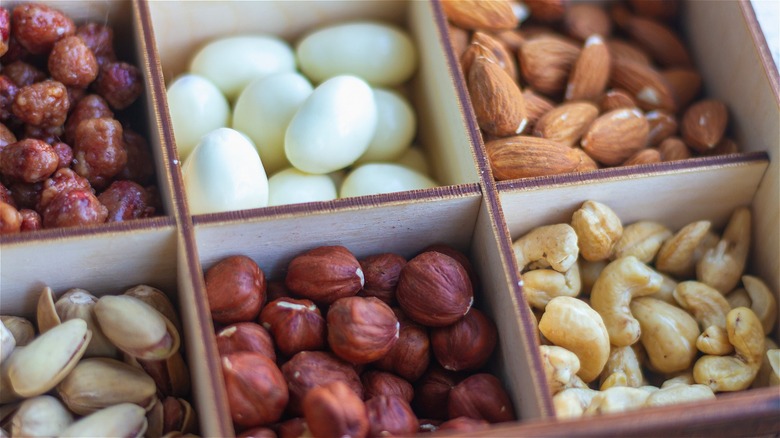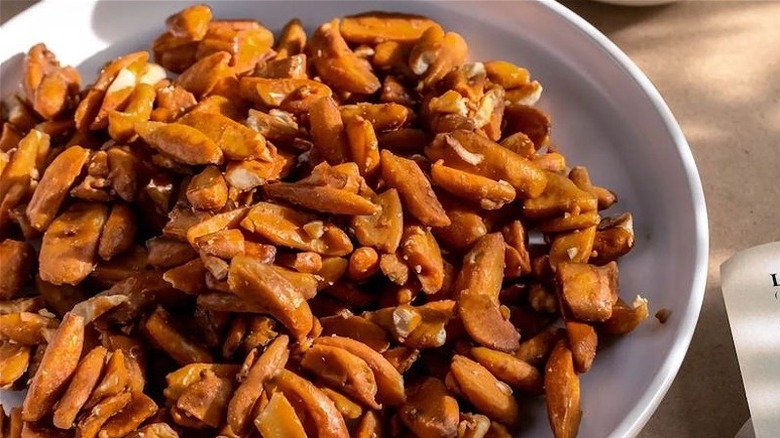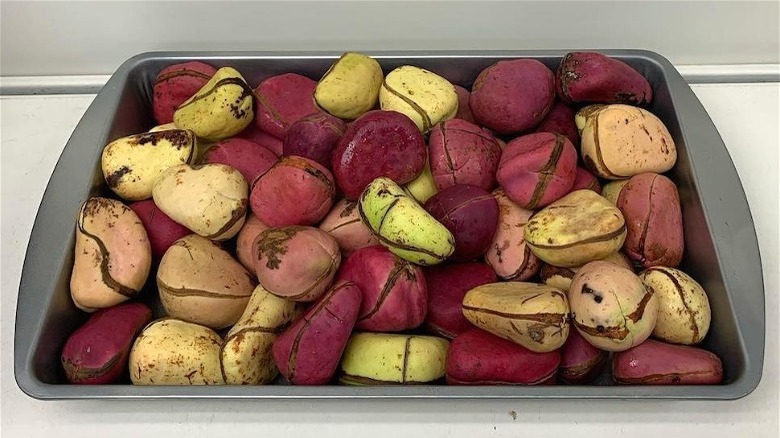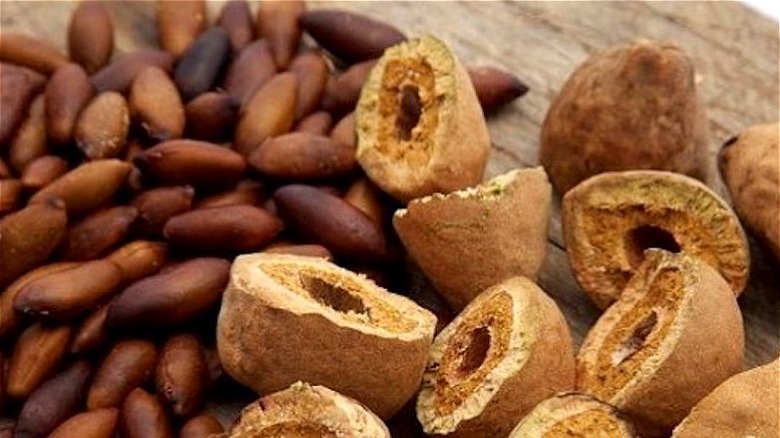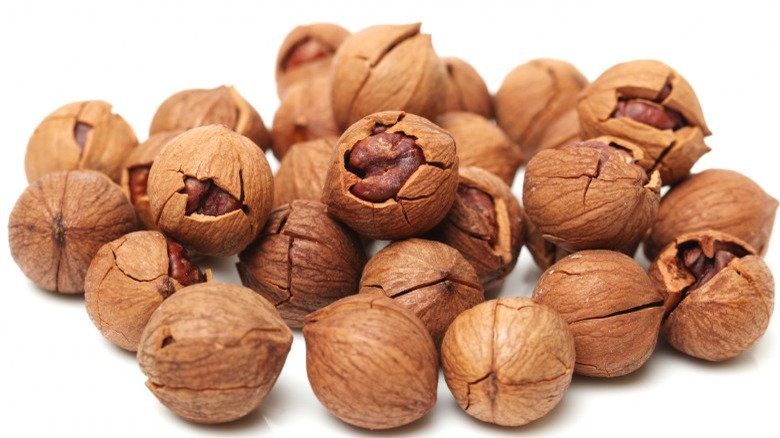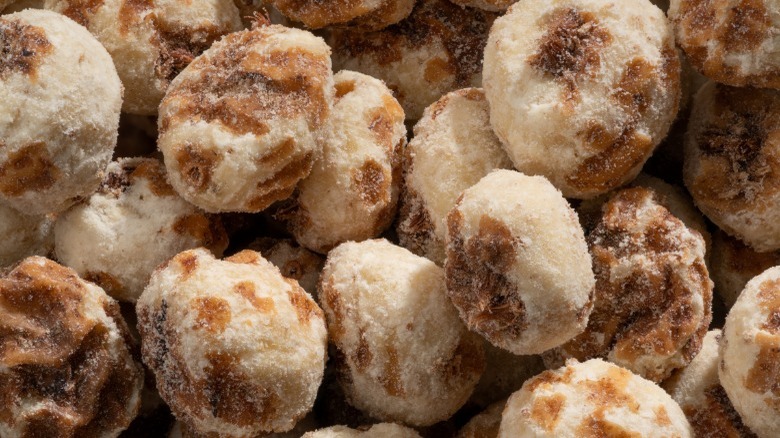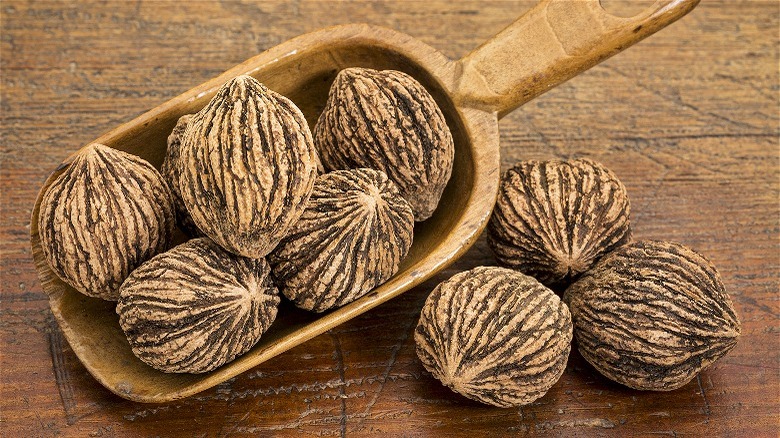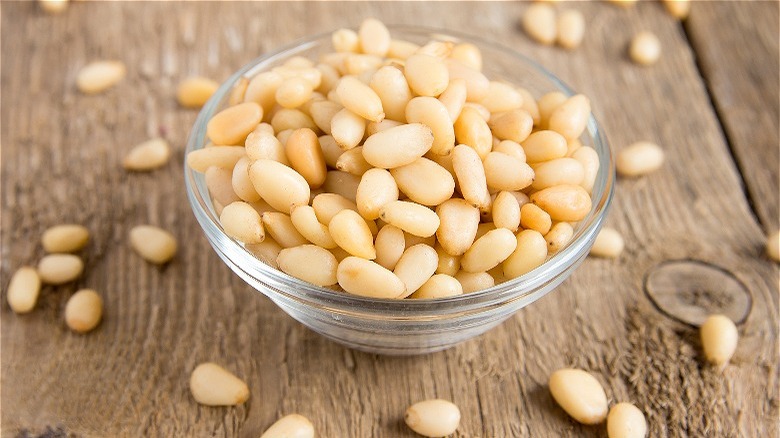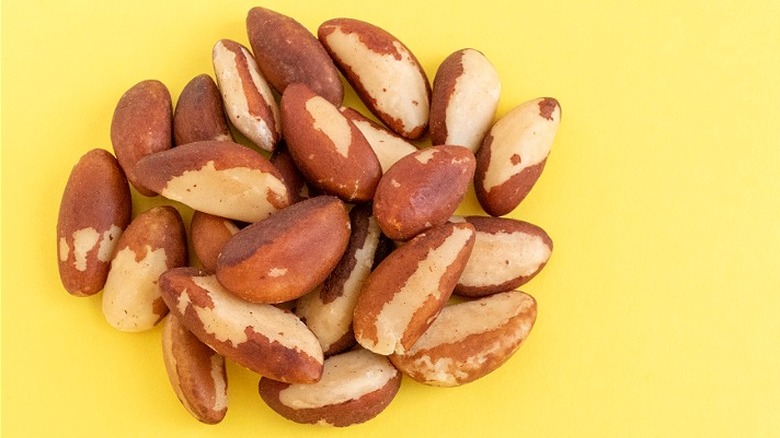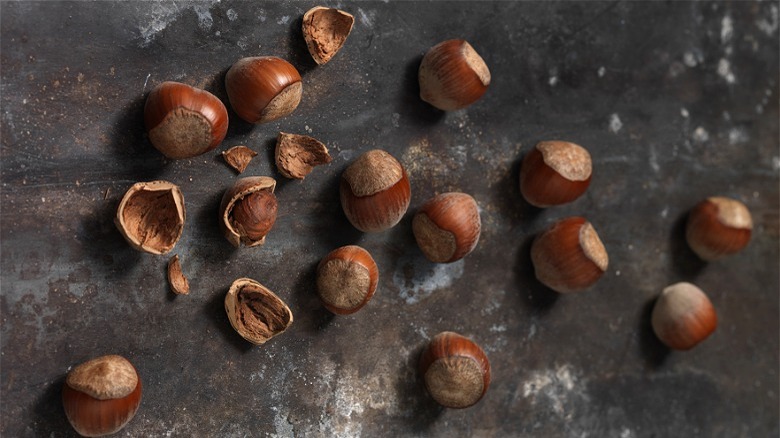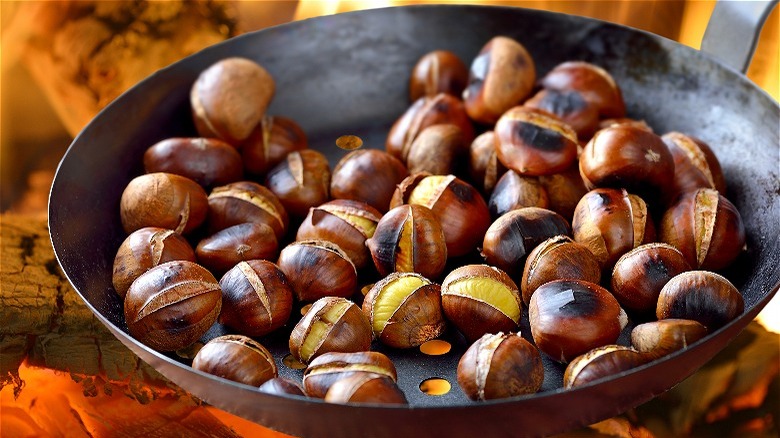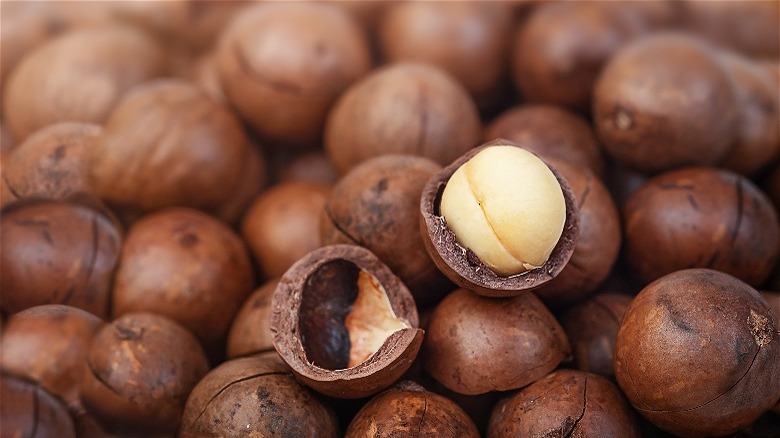11 Of The Most Underrated Types Of Nuts
Nuts are one of those rare foods that are great in their purest form. You may have to crack through their shells, but what's inside is ideal. These foods can taste crunchy and buttery on their own. This is part of what makes them delicious as a snack or trail mix component. But nuts can also be extremely useful culinary tools and can be used in chicken breading, pie crust, pasta filling, vegan cheese, or delicious dips. Raw or roasted nuts can also be added to savory dishes like salads or sweet desserts like French toast for an extra flavor element.
Unless you have an allergy, you've probably tried several nut varieties in your life. Some of the most common are peanuts, pistachios, and almonds. However, all of the aforementioned foods are not actually nuts, by definition. Peanuts are legumes. Pistachios and almonds are seeds. Real nuts include things like hazelnuts, acorns, and chestnuts. These foods are defined as fruits that don't open up to reveal a single seed when mature. To us, it's less important to know what a real nut is than to discover new ones out there.
There are many more nuts in the world than just peanuts and cashews. Eating them may have several health benefits, especially for your heart. Their heart-healthy benefits stem from the fact that they are high in unsaturated fats, fiber, and omega-3 fatty acids. Read on to discover the most underrated types of nuts.
1. Pili nuts
Pili nuts are seeds usually mistaken for nuts. They come from the pili nut tree which is native to the Philippines. Be careful when consuming pili nuts, because they have laxative properties in their raw form. It's common for vendors in Southeast Asia and the Pacific Islands to sell pili nuts. In these instances, the snack is usually fried or roasted. Sometimes, the nuts are also prepared by coating them in sugar.
The pili nut's unique form is somewhat slender and tear-shaped. Like other nuts — or, in this case, seeds thought of as nuts — they are each encased in a hard shell. This shell is notoriously difficult to crack, so companies that sell these nuts have to use special methods to open them. The brand Pili Pushers says that it employs a special knife to individually split each pili nut one by one. What's inside may be worth the effort.
Pili nuts have a creamy, savory taste. When raw, some say they taste like sunflower seeds. Cooked, they taste more like pine nuts, or something in between macadamia nuts and cashews. You may want to try them for yourself to decide, as these little morsels are considered a healthy snack by some. Very Well Fit reports that pili nuts are nutritious for being low in sodium, cholesterol-free, and packed with nutrients like magnesium.
2. Kola nuts
Kola nuts — which are technically seeds — come from Cola trees. If you're already thinking about soda, you're on the right track. The extract of these nuts was originally used to make soft drinks like Coca-Cola. It was utilized in the beverage because kola nuts contain caffeine and sugar, as well as other components commonly found in coffee and tea that help boost energy. The nuts were also used to enliven soda's taste. Even though kola nuts are no longer used in Coca-Cola, they are still worth trying.
Kola nuts themselves are sweet after chewing, but bitter when raw. Don't be surprised when they taste different from your favorite soft drink. The nuts also have a distinct look to them. They have a white exterior when they are freshly picked, but after drying, they can turn pink or reddish-brown. Additionally, don't be shocked when your lips and the inside of your mouth turns orange after eating kola nuts — this is normal.
This former soft drink ingredient is still used as a stimulant in places like West Africa, where people can buy handfuls of kola nuts to snack on, thus boosting their energy. Other than energy, kola nuts have been used to treat many other health issues: Eating these nuts is said to fight infection, ulcers, headaches, depression, and other medical problems, per Healthline.
3. Baru nuts
You may have heard of baru nuts through TikTok, where social media users have shared videos recommending the nuts for their health benefits. According to Very Well Fit, eating baru nuts may be beneficial to your health due to their large concentration of micronutrients. The nuts contain zinc, potassium, iron, calcium, and other vitamins and minerals. These nutrients are part of why baru nuts may help improve your immune system, increase your heart health, and help with weight management.
Despite their name, baru nuts are legumes. Looking at one, you'd probably call it a nut. That's because they have a shiny, dark brown exterior and oblong shape similar to other nuts you've encountered. Baru nuts are said to taste like a mix between peanuts and cashews, with a slight hint of cocoa or coffee in their flavor profile, as well.
They are also considered environmentally friendly. These nuts require less water to grow than almonds. This is partly because baru nuts grow on trees with roots that receive irrigation from underground roots. Some people think that as baru nuts become more popular, fewer trees will be cut down in areas where their trees grow. This is helpful to environmental issues like deforestation.
4. Hickory nuts
There is more than one type of hickory nut out there and not all of them are created equal. Some varieties, like the pignut and bitternut hickories, are inedible, per Leafy Place. But the kingnut variety, as well as hickory nuts that grow on pecan trees, are safe to eat. Edible hickory nuts like these are worth trying for their delicious, somewhat sweet flavor that is similar in taste to pecans.
Hickory nuts are also cherished for their calorie density: One nut can contain around 200 calories. This is great news for experienced foragers who are looking for a snack during their hike. If you know how to correctly identify a hickory nut, you can simply crack through the shell and chow down, because they are safe to be eaten raw. Due to the high amount of calories in each one, an individual hickory nut may seem more filling than other nut types.
If you're eager to grab some free hickory nuts in the wild, you first need to look for their trees. They're said to resemble walnut trees, with thick layers of branches covered in "pinnately compound leaves," reports Delighted Cooking. "The leaves are very mildly serrated." The nuts themselves turn from green to brown as they become ripe, and they have a mostly round shape to them. Because of this, they are easily confused with buckeye nuts. "They have a double layered nut shell like hickory, but buckeye nuts are poisonous," confirms Outdoor Life. "Hickory nuts have a multi chambered inner nutshell (like a walnut), while the toxic buckeyes have a solid nutmeat (like an almond)." If you're not 100% certain, don't chance it.
5. Tiger nuts
Tiger nuts are an up-and-coming food in certain parts of the world. However, in other parts — like Europe and Africa — they've been around for much longer. In Spain, these nuts are famously used to create a drink called "horchata de Chufa."During preparation, the nuts are ground up and sometimes combined with ingredients like cinnamon or lemon. The result is a deliciously sweet drink. Consuming it is said to aid in digestion.
Tiger nuts may contain many additional health benefits, on top of soothing your stomach. Per Healthline, eating them could help reduce your blood sugar levels, boost your immune system, improve heart health, and increase your libido. These potential benefits could stem from the tiger nut's many nutrients, including fiber, iron, vitamin C, magnesium, potassium, zinc, and calcium.
These underrated nuts have a unique look to them. Each nutshell is covered in indentations with a texture that appears like a craggy version of a peanut. The name "tiger nut" comes from the visible stripes on these shells. If you love the look and potential health benefits of eating tiger nuts, you should start enjoying them as soon as possible. They can be eaten raw or cooked. Due to their low protein content, some sources recommend consuming them along with other foods, such as in a trail mix.
6. Black walnuts
Black walnuts are the underrated product of black walnut trees. The wood of these trees is currently more commercially valuable (it's used for creating things like gunstocks and furniture) than black walnuts themselves. But these nuts are worth a second look due to their excellent nutrition and delicious taste.
According to Healthline, eating black walnuts may help with several areas of a person's health and wellness. Consuming them could improve heart health, help prevent cancer, aid in weight loss, and they contain antibacterial properties, too. They are particularly beloved for their tannins, omega-3 fatty acids, and ellagic acid, all of which benefit your heart. Black walnuts are even used in creating nutritional supplements such as wormwood.
The nuts have a strong bitter flavor that may be off-putting to some, though others may find this natural taste pleasantly vegetal. You can eat them raw, but it's common practice to use them in baking recipes, such as black walnut pie. You can recognize these nuts by their green, round shapes that blacken with ripening. This outer layer is one of two that need to be removed to get to the edible part. They look very different from your typical walnuts (they are small and break into little pieces), so their appearance after being shelled should make it easy to identify black walnuts at the grocery store.
7. Pine nuts
If you've ever had pesto or pignoli cookies, you are already familiar with pine nuts, but there is so much more to them than these two famous Italian recipes. They are delicious raw (when they taste sweet, milky, and buttery) or roasted (when they are nutty and crispy). Cooking pine nuts also activates their scent, giving them an aromatic component that works well in several different types of recipes. You can use raw or toasted pine nuts to add a flavorful crunch to dishes like salads, dips (such as hummus), or even mixed into a bread dough. These versatile nuts even work in dessert recipes like pie crusts.
In addition to tasting great, eating pine nuts may also be beneficial to your health. Consuming pine nuts could help improve blood sugar levels, promote heart health, maintain a healthy weight, and improve your brain health, as noted by Healthline. Because the nuts also contain nutrients like iron, protein, and magnesium, they may also increase your energy levels, according to WebMD.
Unsurprisingly, pine nuts come from the humble pine tree. Some common varieties used for producing pine nuts are the pinyon pine and the stone pine trees. These plants grow pine cones, and their seeds are the nuts you can purchase in bulk at the grocery store.
8. Brazil nuts
Brazil nuts are often found in snack mixes. However, when they appear alongside more common nuts such as almonds or pistachios, they are often overlooked. If you completely ignore brazil nuts, then you're making a mistake: They come with a unique shape, flavor, and admirable health benefits. Combined, these qualities could make brazil nuts your new favorite snack.
Consuming these nuts may help with certain health issues such as diabetes, inflammation, bone health, and brain function, according to WebMD. Brazil nuts also contain several beneficial nutrients. Each nut has calcium, magnesium, zinc, phosphorus, manganese, vitamin E, vitamin B6, and vitamin B1. And, as an added bonus, you can eat them raw or cooked.
These nuts are technically seeds. They grow inside large pods, which hang from trees native to the Amazon. Each pod contains between eight and 24 nuts. In the store, it's unlikely that you're going to come across Brazil nuts in their shells or pods. Instead, you'll find that they look large, white, and crescent-shaped. Their taste is nutty but is overall milder than other nuts.
9. Hazelnuts
You've probably come across the hazelnut in its many culinary uses rather than in its raw form. These nuts are often used in dessert recipes, and hazelnut-flavored coffee is offered on various menus. You'll find that they are a common component in cookies, tarts, pastries, pies, and macaroons. It's also the key ingredient in the iconic, delicious Nutella spread. The nuts are even used to make flavored alcoholic beverages such as hazelnut liqueur. We recommend sampling these food and beverages made with hazelnuts, as well as trying the nuts in their raw form.
Their many uses show the versatility and popularity of hazelnuts, as well as their flavor. People are also fond of these nuts for their nutritional value. They contain vitamins and minerals such as magnesium, copper, manganese, thiamin, fiber, vitamin E, and more, per Healthline. Eating hazelnuts may help with issues such as inflammation, blood sugar changes, gaps in your diet, heart issues, and oxidative stress.
Due to their similarity in size and shape to pistachios, almonds, and peanuts, you may find that hazelnuts mix well with these popular options. These similarities may even make hazelnuts seem more appetizing. You can identify a hazelnut by its small, round shape. They either appear a creamy tan color or have a reddish-brown outer shell.
10. Chestnuts
You may know chestnuts as that food mentioned in the famous holiday tune "The Christmas Song," in which Nat King Cole sings about roasting them on an open fire. They've become part of popular culture as a result of this, but these nuts are more than just well-known lyrics. Chestnuts have unique and attractive qualities. For one, they change in both texture and taste when they are heated. Chestnuts are bitter and hard before they are cooked, but, after a little roasting, these nuts become deliciously soft and savory. You can see why the image of cooking chestnuts would be worth singing about.
Chestnuts are also considered nutritious, according to Healthline. They may boost heart health, fiber levels, and blood sugar fluctuations. The nuts also contain vitamins and minerals such as potassium, vitamin C, vitamin B6, copper, manganese, fiber, and protein. You can identify a chestnut by its unique shape: The nuts look like spheres that have been slightly compressed on both sides. Before peeling, the exterior of a chestnut is dark brown. After, the chestnut will have a golden-brown hue.
11. Macadamia nuts
While they are potentially harmful to dogs, most people can eat macadamia nuts. These nuts are probably underrated due to their sometimes expensive cost, but macadamia nuts are delicious on their own or in recipes such as macadamia nut brownies. They are also highly nutritious. For these reasons, you might want to check them out.
Eating macadamia nuts may help with certain health conditions. Per Healthline, ingesting these nuts could aid in weight loss, boost heart health, lower your chances of having metabolic syndrome, improve brain function, and more. Some of these positive side effects may be far off, but the nutritional profile of macadamia nuts doesn't lie. This plant food contains beneficial vitamins and minerals like iron, magnesium, copper, manganese, and fiber.
You're probably going to come across macadamia nuts without their shells. We recommend buying them after the shells have been removed because they are extremely hard to crack open. If you encounter a whole macadamia nut, the surface will be brown. Once peeled, macadamia nuts are small, white, and round.
